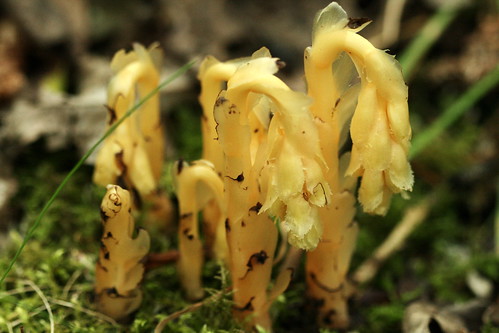Yellow Birds Nest Monotropha hypopitys
Species & Site Managament Account Under Construction
Family
Ericaceae
Species Description
Yellow bird’s Nest Monotropa hypopitys AKA Ductchmans Pipe is a short, perennial plant, growing to 30cm..
The whole plant is a waxy, pale brownish-yellow.
Flowers are tubular with 4 to 5 sepals united at the base
The 4/5 petals are dull yellow, 8-12 mm long on a drooping stem that becomes erect in fruit.
Leaves are scale-like and close to the stems.
Plants are fleshy and grow 10–35 cm tall.
True stems are nonexistent. Instead, the only part which emerges from the soil are unbranched adventitious inflorescenceswhich are developmentally similar to adventitious roots.[2] All parts of the plant are pale yellowish white to reddish-tinged. The bracts are 5–10 mm long scale-like structures, which cover most of the inflorescence. Plants flower from April to December depending on the geographic region (June to September in North America). The flowers are pendulous when young, but become erect when they begin to mature into the fruit which is a capsule. The flowers are 9–12 mm long and produced in a cluster of 1–11 together at the apex of the inflorescence, which is a raceme. It flowers between early summer and mid autumn; plants that flower in summer are yellow and sparsely hairy, while those that flower in autumn are red and densely hairy. These two color "forms" overlap in flowering time. It has been suggested that yellow individuals are largely self-pollinating.[3]
It is considered to have two subspecies (Stace 1997), but morphology is not always reliableand a need to check chromosome number to be absolute
The whole plant is a waxy, pale brownish-yellow.
Flowers are tubular with 4 to 5 sepals united at the base
The 4/5 petals are dull yellow, 8-12 mm long on a drooping stem that becomes erect in fruit.
Leaves are scale-like and close to the stems.
Plants are fleshy and grow 10–35 cm tall.
True stems are nonexistent. Instead, the only part which emerges from the soil are unbranched adventitious inflorescenceswhich are developmentally similar to adventitious roots.[2] All parts of the plant are pale yellowish white to reddish-tinged. The bracts are 5–10 mm long scale-like structures, which cover most of the inflorescence. Plants flower from April to December depending on the geographic region (June to September in North America). The flowers are pendulous when young, but become erect when they begin to mature into the fruit which is a capsule. The flowers are 9–12 mm long and produced in a cluster of 1–11 together at the apex of the inflorescence, which is a raceme. It flowers between early summer and mid autumn; plants that flower in summer are yellow and sparsely hairy, while those that flower in autumn are red and densely hairy. These two color "forms" overlap in flowering time. It has been suggested that yellow individuals are largely self-pollinating.[3]
It is considered to have two subspecies (Stace 1997), but morphology is not always reliableand a need to check chromosome number to be absolute
ssp. hypophegea (Wallr.) Holmboe which is glabrous and has a chromosome number 2n = 16 (Stace 2010).
ssp. hypopitys, which has pubescent stamens, carpels and petals; 2n = 48 (Stace 2010).
Biology
This plant does not contain chlorophyll; it is a myco-heterotroph, getting its food through parasitism upon fungi rather than photosynthesis. Monotropa contains no chlorophyll, and was until recently thought to be saprophytic (deriving nutrients from decaying leaf litter) but recent research shows that it is actually epiparasitic, using Tricholoma fungi to extract nutrients from living trees in its vicinity (Leake et al. 2004). These fungi form a mycorrhiza with nearby tree species.has popularly been described as a saprophyte, howe
ver it is more appropriate to classify yellow bird’s nest as a myco-heterotroph meaning it gains energy from mycorrhizal fungi (Leake 2005). M. hypopitys roots are sheathed in ectomycorrhizal fungal mycelium, and nourished exclusively by carbon passing through a common mycorrhizal network linked to adjacent autotrophic trees, deciduous or coniferous It is usually found in woods or in scrub.
Status
Origin: native. It was first recorded by Robert Plot at Stokenchurch in 1677 (Clarke 1900), although he mentions earlier records by John Goodyer (1592-1664), which must pre-date this.
Origin: native. It was first recorded by Robert Plot at Stokenchurch in 1677 (Clarke 1900), although he mentions earlier records by John Goodyer (1592-1664), which must pre-date this.
Nationally Scarce species in Britain, Recorded in 103 hectads in the New Atlas (Preston et al. 2002).
Threat: its status in the JNCC Red List (Cheffings & Farrell 2005) is ‘endangered’ - an assessment based on the Change Index, which shows it to be declining in Britain. Rumsey, in the New Atlas, also describes it as having suffered a prolonged decline.
Conservation: It is listed it as an ++ axiophyte, but it is not quite obvious which BAP habitats it occurs in. It is debatable whether it really warrants such a status, and more research is needed.
++ Lists of axiophytes for various BAP habitats can be used as an empirical measure for sites of nature conservation interest. This allows landowners and others to see how decisions have been made.
References & Citations
Lockton, A.J. & Walker, K.J. (date accessed). Species account: Monotropa hypopitys. Botanical Society of the British Isles, www.bsbi.org.uk.
Leake J. R., Mckendrick S. L., Bidartondo M. & Read D. J. 2004. Symbiotic germination and development of the myco-heterotroph Monotropa hypopitys in nature and its requirement for locally distributed Tricholoma spp. New Phytologist 163, 405-423.
National Distribution Please Allow Time to Load
.
VC 63 Distribution Please Allow Time to Load

No comments:
Post a Comment